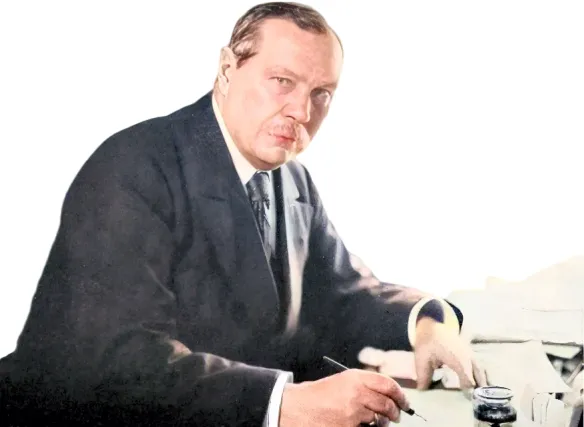Introduction
Sir Arthur Conan Doyle, famous for creating the iconic detective Sherlock Holmes, was not only a literary giant, but also a pioneer of alternative medicine. Among his lesser-known but important advocacy, he championed osteopathy, a relationship rooted in personal experience and a sincere belief in its benefits.
Born on May 22, 1859, in Edinburgh, Scotland, Conan Doyle spent his youth studying medicine at the University of Edinburgh, where he was exposed to a variety of medical practices and philosophies. This training in traditional medicine gave him a solid understanding of human health and the intricacies of the body, which later influenced his openness to alternative treatments.
Conan Doyle’s path to literary fame began with the creation of Sherlock Holmes, first introduced in the novel “A Study in Scarlet” in 1887. Holmes’ character, with his keen intelligence, keen observational skills and methodical approach to solving mysteries, captivated readers around the world. Conan Doyle’s success as a writer, however, did not protect him from the physical illnesses that plagued his life.
Throughout his life, Conan Doyle suffered from a variety of health issues, including chronic pain and fatigue. These issues often hampered his ability to work and impacted his overall well-being. Traditional medical treatments of the time offered limited relief, prompting Conan Doyle to seek alternative solutions. It was during this quest for better health that he discovered osteopathy, a holistic approach to medicine that focuses on the body’s musculoskeletal system and its ability to heal itself.
Osteopathy, founded by Dr. Andrew Taylor Still in the late 19th century, was relatively new when Conan Doyle discovered it. The principles of osteopathy, which emphasize the interrelationship between the body’s structure and function and its inherent ability to heal, resonated with Conan Doyle’s scientific and logical mind. After experiencing significant improvements in his health through osteopathic treatments, Conan Doyle became a strong proponent of this alternative therapy.
His advocacy for osteopathy was not limited to personal endorsement. Conan Doyle used his influence to promote osteopathy to a wider audience. He wrote articles and gave public lectures extolling the benefits of osteopathic treatment, often drawing parallels between osteopathy’s meticulous, evidence-based approach and the deductive reasoning of his famous detective, Sherlock Holmes. Conan Doyle’s support played a crucial role in raising awareness of osteopathy and its potential benefits at a time when it was struggling to gain recognition within the wider medical community.
Furthermore, Conan Doyle’s embrace of osteopathy highlighted his progressive views on health and well-being. He recognized the importance of looking beyond conventional medicine to a more holistic approach to health, a perspective that was ahead of his time. His belief in the efficacy of osteopathy and his efforts to legitimize it reflect a forward-thinking attitude that sought to integrate complementary therapies into mainstream health care.
Today, Sir Arthur Conan Doyle’s legacy extends beyond his literary works to include his contributions to the acceptance and recognition of osteopathy. His support for this alternative medical practice underscores the depth of his understanding of human health and his commitment to improving the quality of life, not only through his stories but also through his advocacy for innovative medical treatments.
Historical context
Osteopathy, founded by Andrew Taylor Still in the late 19th century, arose from a time when traditional medicine was often perceived as inadequate and sometimes even harmful. Medical practices at the time were dominated by invasive methods such as bloodletting and the excessive use of medication. In this context, the search for alternative approaches became a necessity for many patients.
Still, himself a physician, was deeply affected by personal experiences of loss, including the deaths of his children, which led him to rethink conventional medicine. He believed that the human body had the capacity to heal itself and that health care should focus on this capacity. This led him to develop osteopathy, a practice that aims to treat the body as a whole, taking into account not only physical symptoms but also the patient’s emotional and environmental state.
Osteopathy is distinguished by its holistic and manual approach, emphasizing manipulation techniques to improve blood circulation and the function of body systems. At that time, osteopathy was a radical innovation, as it offered an alternative model to allopathic medicine. The opening of the first osteopathic school in Kirksville, Missouri, in 1892, marked a turning point in the history of medicine, allowing this practice to gain visibility and credibility.
By the early 20th century, osteopathy was beginning to spread beyond the United States. Osteopathic-trained practitioners emerged in various countries, seeking to establish clinics and schools. This expansion contributed to an increased awareness of osteopathy as a viable treatment option. In Europe, discussions emerged about integrating osteopathy into public health systems, sparking heated debates among health professionals.
At this time, Sir Arthur Conan Doyle, as a renowned writer, had a significant influence in supporting osteopathy. His own health journey, marked by chronic pain and well-being issues, led him to explore this alternative approach. Conan Doyle discovered the benefits of osteopathy, which led him to share his experience through his writing. His testimonies not only raised awareness among the public, but also increased the acceptance of osteopathy by the medical community.
The years that followed saw growing recognition of osteopathy, although the struggle to establish its legitimacy was long. Osteopaths had to navigate between skepticism and approval, while continuing to refine their practices. Osteopathy evolved to include elements of scientific research and clinical studies, thus strengthening its status within medical practices.
Today, osteopathy is recognized in many countries as a legitimate medical discipline, integrating preventive and wellness approaches. The historical context in which it emerged underlines the importance of research into alternative and holistic treatments. The legacy of pioneers such as Still and Conan Doyle continues to influence modern osteopathic practice, proving that the integration of body, mind and environment remains essential in the healing journey.
The Life and Literary Genius of Sir Arthur Conan Doyle
Born on May 22, 1859 in Edinburgh, Scotland, Sir Arthur Conan Doyle leaves a literary legacy without equal. His contributions to literature, particularly through the creation of the iconic detective Sherlock Holmes, have left an indelible mark on the literary world and popular culture.
Conan Doyle’s early years were marked by a rich series of experiences that would later shape his literary endeavors. He was raised in a modest family, where storytelling was a popular pastime. This early exposure to storytelling stimulated his imagination and set the stage for his future as a master storyteller.
After completing his studies, Conan Doyle studied medicine at the University of Edinburgh, where he honed his analytical skills and developed a deep understanding of human anatomy and physiology. While studying medicine, he also nurtured his passion for writing, writing his first stories and essays for various publications.

Conan Doyle’s literary career really took off with the creation of Sherlock Holmes, a character who would become synonymous with detective fiction. First appearing in the 1887 novel A Study in Scarlet, Holmes captivated readers with his brilliant deductive reasoning, keen observational skills, and enigmatic personality. The success of Sherlock Holmes catapulted Conan Doyle to literary stardom, making him one of the most influential writers of his time.

Beyond his writing, Conan Doyle’s life was marked by a wide variety of interests and projects. His background in medicine informed not only his writing, but also his curiosity about the human condition. He had a deep interest in spiritualism and the occult, which he explored through his writing and personal experiences. In addition, Conan Doyle was a strong advocate for social justice, lending his voice to a variety of causes, including the plight of indigenous peoples and the fight against injustice and inequality.
Throughout his life, Conan Doyle devoted himself to his craft, producing a prolific body of work that spanned multiple genres and mediums. From detective novels to historical novels, from short stories to essays, his writing showcased his versatility and narrative prowess. Despite the criticism and controversy he sometimes attracted, Conan Doyle’s enduring legacy as a writer continues to inspire readers and writers alike, cementing his status as a literary genius for generations to come.
Personal impact
The personal impact of osteopathy on Sir Arthur Conan Doyle is a crucial dimension of his commitment to the practice. As a prolific writer, known primarily for his Sherlock Holmes stories, Conan Doyle also led a personal life marked by health struggles. He suffered from a variety of physical problems, including chronic pain and persistent headaches, which hampered his quality of life and ability to work.
It was in this context that he discovered osteopathy. In seeking a solution to his pain, he turned to an osteopath, hoping to find relief from his health problems. This contact was decisive. Thanks to the osteopath’s manual techniques, Conan Doyle noticed a significant improvement in his symptoms. His pain was reduced, allowing him to find a better quality of life and increased productivity in his writing.
This personal transformation had a profound impact on Conan Doyle, who began to see osteopathy not just as a treatment, but as a philosophy of life. He understood that physical well-being was intimately linked to mental and emotional state. This realization led him to become more interested in the principles of osteopathy, which advocate a holistic approach to health care.
The impact of osteopathy on his life also influenced his perception of medicine and health in general. Conan Doyle became a strong advocate for osteopathy, sharing his positive experiences with his readers and the medical community. He wrote several articles and essays discussing the benefits of osteopathy, emphasizing its effectiveness over conventional medical treatments.
In his writings, he advocated for a more integrated and humane approach to health care, arguing that medicine should consider the whole individual. His testimonies played a key role in increasing the recognition of osteopathy, and he helped encourage others to explore this form of treatment. Conan Doyle’s influence was such that he opened doors for other patients, inspiring them to seek alternative solutions to their health problems.
His experience with osteopathy also impacted his creativity and work. Freed from chronic pain, Conan Doyle was able to devote more time and energy to writing. This artistic renaissance is a testament to the positive impact that a holistic approach can have on an individual’s health and well-being.
Ultimately, the personal impact of osteopathy on Conan Doyle goes far beyond simply improving his symptoms. He is a shining example of how alternative medicine can transform lives. His commitment to and advocacy for osteopathy helped legitimize it in the medical world. His legacy lives on today, inspiring many to consider osteopathy as a viable option for their health.
Reception of osteopathy
In the early 20th century, the reception of osteopathy was marked by a complex interplay of skepticism and enthusiasm. As osteopathy emerged as an alternative to conventional medical treatments, it faced significant criticism from the established medical community. Many physicians viewed osteopathy as a threat to their practices, sometimes dismissing it as a passing fad or quackery.
However, influential figures like Sir Arthur Conan Doyle played a crucial role in promoting osteopathy. His positive personal experiences with the practice enabled him to become a passionate advocate, sharing testimonials about its effectiveness through writings and speeches. These accounts resonated with a broad audience, helping to awaken interest in osteopathy as a legitimate therapeutic option.
The media of the time also began to take notice of osteopathy, reporting success stories and health improvements attributed to this approach. Such narratives contributed to a more favorable public perception of osteopathy. The growing interest in alternative treatment methods opened avenues for discussions within the medical community regarding the integration of osteopathy into the medical landscape.
Despite this positive momentum, resistance to osteopathy remained strong. Practitioners of traditional medicine, even when pressured to examine osteopathy objectively, often maintained their skepticism. This dynamic led to heated debates, with some asserting that osteopathy lacked solid scientific foundations. In response to these criticisms, osteopaths intensified their efforts to demonstrate the efficacy of their treatments through studies and clinical research.
In the 1920s and 1930s, movements advocating for the integration of osteopathy into healthcare systems began to emerge. Professional organizations were established to promote and legitimize this approach. Osteopathic schools were founded, and research was conducted to assess the effectiveness of osteopathic treatments. These efforts gradually bore fruit, and osteopathy gained recognition within the medical community.
By the 1930s, the climate surrounding osteopathy began to shift. Physicians and health practitioners started to recognize that osteopathy could offer complementary solutions to traditional care. Patients, in turn, began to seek out osteopaths for more personalized treatments. This dynamic fostered a more constructive dialogue between osteopaths and traditional doctors.
The increasing recognition of osteopathy was also reflected in the establishment of regulations and standards for practice. Many countries began to integrate osteopathy into their healthcare systems, thereby providing greater legitimacy to practitioners. This process was supported by scientific evidence and clinical studies that demonstrated the effectiveness of osteopathic techniques.
Over time, osteopathy adapted to the modern demands of medicine. Osteopaths began collaborating with other healthcare professionals, creating interdisciplinary teams to provide integrated care. This collaboration enhanced the perception of osteopathy as a serious and respected medical practice.
Despite his immense success as a writer, Sir Arthur Conan Doyle had to deal with considerable health problems throughout his life. These difficulties were characterized by chronic pain and various disorders that had a significant impact on his daily activities and overall quality of life. His health problems led him to continually seek effective medical treatments, eventually leading him to a deep appreciation of osteopathy.
Conan Doyle’s health problems began early in his life and persisted into adulthood. He suffered a severe bout of influenza in his youth, which left him with long-term complications. As he grew older, he experienced frequent bouts of exhaustion and debilitating pain, particularly in his back and shoulders. These problems were exacerbated by the physically demanding and stressful nature of his work, both as a doctor and later as a prolific author.
His medical background gave him a unique perspective on his ailments. Although he was well-versed in the conventional medical practices of his time, the treatments he received often provided only temporary relief. The frustration of dealing with persistent health problems despite his medical knowledge and access to traditional treatments fueled his interest in alternative therapies. This quest for a more effective solution led him to osteopathy, a then-emerging field that promised a holistic approach to health and healing.
Osteopathy, founded by Dr. Andrew Taylor Still in the late 19th century, appealed to Conan Doyle because of its emphasis on the body’s natural ability to heal itself. The practice focuses on the musculoskeletal system, using manual techniques to improve circulation, relieve pain, and improve overall health. This approach fit Conan Doyle’s scientific mindset, as it was based on a detailed understanding of human anatomy and physiology.
Conan Doyle’s direct experiences with osteopathy proved transformative. The treatments he received not only relieved his chronic pain, but also improved his general well-being, allowing him to pursue his literary work with renewed vigor. His positive experiences with osteopathy inspired him to become a strong advocate for the practice. He firmly believed in its potential to help those who, like himself, had found little solace in conventional medicine.
In addition to his personal support, Conan Doyle’s support for osteopathy reflected his broader commitment to the advancement of medical knowledge and patient care. He used his influence to raise public awareness of osteopathy, writing articles and speaking publicly about its benefits. His advocacy contributed to the growing recognition of osteopathy as a legitimate medical practice, paving the way for its integration into mainstream health care.
Conan Doyle’s health struggles and subsequent adoption of osteopathy highlight his relentless pursuit of wellness and his willingness to explore innovative solutions. His journey underscores the importance of a holistic approach to health, which considers the interplay of physical, mental, and emotional factors to achieve overall well-being. Through his personal struggles and advocacy, Conan Doyle left a lasting mark on the field of osteopathy, enriching his legacy beyond his literary contributions.
Discovery of osteopathy
Sir Arthur Conan Doyle’s introduction to osteopathy marked a turning point in his life. This holistic approach to health care, centered on the musculoskeletal system, resonated deeply with him and ultimately changed the course of his health journey.
Conan Doyle likely discovered osteopathy at a time when traditional medical treatments were not providing the relief he sought for his chronic pain and various health problems. The principles of osteopathy, which emphasized the body’s innate ability to heal itself through manual manipulation and manipulation of the musculoskeletal system, offered a refreshing alternative to conventional medical practices.
Experiencing first-hand the significant improvement in his health following osteopathic treatments, Conan Doyle became a passionate believer in the practice’s potential to transform lives. The relief he experienced from his symptoms not only alleviated his physical discomfort, but also restored his sense of vitality and well-being. This personal transformation fueled his passion for osteopathy and motivated him to share its benefits with others.
Conan Doyle championed osteopathy based on his sincere belief that it could help others as it had helped him. He recognized the profound impact that osteopathic treatment could have on the health and quality of life of individuals, and he was determined to make its merits known.
Conan Doyle, who became a vocal advocate for osteopathy, used his fame and influence to advocate for the practice. Through his writings, public speaking, and support for legislative efforts, he sought to elevate the status of osteopathy within the medical community and society at large. His advocacy efforts were motivated by a sincere desire to make osteopathic treatment accessible to all who could benefit from it, reflecting his commitment to promoting holistic approaches to health care.
Conan Doyle’s Plea for Osteopathy
Sir Arthur Conan Doyle’s support for osteopathy transcended his personal experience, as he actively promoted the practice and advocated for its recognition within the medical community. Taking advantage of his influential status, Conan Doyle embarked on a multi-faceted campaign to highlight the benefits of osteopathy and ensure its rightful place in healthcare.
Writing articles was a powerful tool for Conan Doyle to disseminate information about osteopathy to a wider audience. Through publications in newspapers, magazines, and medical journals, he shared his own positive experiences with osteopathic treatment and presented compelling arguments for its effectiveness. By drawing on his expertise as a respected author and qualified health professional, Conan Doyle gave credibility to the practice and helped dispel misconceptions surrounding it.
In addition to his writing, Conan Doyle actively spoke publicly to advocate for osteopathy. Whether addressing medical conferences, public forums, or community gatherings, he used his oratory skills to passionately advocate for the merits of osteopathic treatment. By sharing anecdotes, testimonials, and scientific evidence, Conan Doyle effectively conveyed the transformative impact of osteopathy on individual health and well-being.
Conan Doyle also recognized the importance of legislative efforts to ensure the recognition of osteopathic practitioners. He supported initiatives to establish licensing and accreditation standards for osteopathy, thereby legitimizing the profession within the broader medical landscape. Through his advocacy, Conan Doyle sought to ensure that osteopathic practitioners received the recognition and respect they deserved, paving the way for greater acceptance and integration of osteopathy into mainstream health care.
Conan Doyle’s commitment to osteopathy exemplifies his dedication to advancing medical knowledge and improving patient care. By using his influence and platform to advocate for this alternative medical practice, he demonstrated an unwavering belief in its potential to improve the health and well-being of individuals. Conan Doyle’s advocacy efforts not only contributed to the growing recognition of osteopathy, but also highlighted the importance of open-mindedness and innovation in health care. His legacy as a tireless advocate for osteopathy is a lasting testament to his progressive spirit and unwavering dedication to promoting holistic approaches to healing.
Impact on his life and work
The relief that Sir Arthur Conan Doyle found through osteopathy had a profound impact on his personal well-being and his professional achievements as a writer. While chronic pain and various ailments had previously hampered his ability to work and enjoy life to the fullest, the newfound relief provided by osteopathic treatments likely played a significant role in improving his productivity and creativity.
Conan Doyle’s health problems are well known and they often hampered his daily activities and creative pursuits. Chronic pain, fatigue and other ailments could easily disrupt his writing process and sap his spirits. However, the effective relief he experienced through osteopathic treatments gave him a renewed sense of vitality and resilience.
By relieving the physical discomfort that had plagued him for years, osteopathy allowed Conan Doyle to focus more on his art. The reduction in pain likely improved his concentration, allowing him to immerse himself more deeply in his writing and sustain longer periods of creative effort. As a result, he was able to produce a greater volume of work and maintain a higher standard of quality in his literary output.
Furthermore, the positive impact of osteopathy on Conan Doyle’s overall well-being cannot be overstated. Beyond the immediate relief of symptoms, osteopathic treatments may have contributed to his overall sense of health and vitality, promoting a greater sense of emotional and mental well-being. This, in turn, likely strengthened his resilience to life’s challenges and allowed him to approach his work with a more positive and optimistic mindset.
The integration of osteopathy into Conan Doyle’s life not only improved his physical health, but also enriched his creative process. By addressing the root causes of his discomfort and restoring balance to his body, osteopathy allowed him to tap into his full potential as a writer. This is a powerful reminder of the profound impact that health and well-being can have on a person’s professional achievements, highlighting the importance of prioritizing self-care and holistic approaches to well-being.
Essentially, the relief Conan Doyle found through osteopathy not only improved his personal quality of life, but also played a crucial role in shaping his lasting legacy as one of the most beloved and prolific writers in literary history.
Legacy
Sir Arthur Conan Doyle’s legacy in the field of osteopathy is undeniable and continues to this day. As a passionate advocate for the practice, he paved the way for its acceptance in the medical world, contributing to a more positive perception of osteopathy. His advocacy for holistic, patient-centered treatments has resonated throughout the decades, influencing not only his time, but future generations as well.
Conan Doyle showed that osteopathy was not just a passing fad, but a valid and effective therapeutic approach. His commitment to osteopathy was motivated by his own healing experience and his desire to improve the health and well-being of others. By sharing his personal story, he helped create a dialogue around alternative medicine and the importance of an integrated approach to health care.
Today, osteopathy is recognized as a form of complementary health care in many countries. Trained practitioners are present in public health systems, offering treatments that address the physical, mental and emotional aspects of health. Conan Doyle’s legacy, through his advocacy and experiences, has played a central role in this recognition. His writings continue to inspire many osteopaths and health practitioners, who seek to promote a holistic approach to care.
Moreover, Conan Doyle’s influence extends to osteopathic education as well. The principles he championed are incorporated into the training of future osteopaths, who learn not only manual techniques but also the importance of listening and compassion in medical practice. His legacy is reflected in the core values that underpin modern osteopathy, echoing his call for a more humane and empathetic medicine.
Conclusion
In conclusion, Sir Arthur Conan Doyle, famous for bringing Sherlock Holmes to life, also played a crucial role in the promotion and recognition of osteopathy. Through his own health journey marked by persistent challenges, Conan Doyle discovered in osteopathy a holistic approach that not only relieved his physical pain, but also revitalized his personal commitment to well-being. His passionate advocacy for this alternative medical discipline contributed to its wider acceptance and legitimacy in the medical community, leaving a lasting legacy that extends beyond his literary exploits.
References
Conan Doyle, Arthur. “The Case for Osteopathy. » The Strand Magazine, vol. 22, no. 130, 1901, p. 561-566.




























